Spending free time outdoors is much more convenient and comfortable on the veranda than in a gazebo located at some distance from the house. Various technologies can be used to create a building. The most popular is the glazing of the terrace with polycarbonate. This procedure is simple enough to do it yourself without much difficulty, but in compliance with certain rules.
Features of the use of polycarbonate for veranda glazing
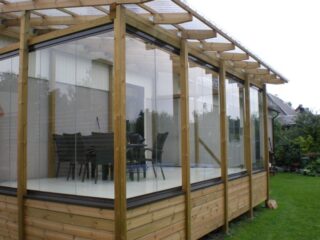
Polycarbonate is a transparent panel made of polymer components. To protect against external factors, ultraviolet additives are added to the raw materials during production, and a dense film is applied on top. Products are manufactured in honeycomb and monolithic versions, both types are successfully used in private construction.
The use of polycarbonate instead of glass on the veranda is justified by its unique properties:
- Presentable appearance. Plates look great, perform not only a protective, but also an aesthetic function.
- Flexibility. The panels can be given the most sophisticated and fanciful shapes.
- Low specific gravity. The ability to create large structures without a heavy foundation.
- High technical characteristics. Transparent polycarbonate as glass for a veranda is highly durable, transmits light well, does not support combustion.
- Environmental Safety. Lack of emission of harmful substances during heating and contact with reagents.
- Good thermal insulation properties. If you close the terrace for the winter with polycarbonate, if there is heating, you can relax there without any problems and even make a greenhouse.
- Ease of installation. Even a beginner can make opening and even sliding polycarbonate windows on the veranda.
When choosing a polycarbonate glazing option for an extension to a house, in addition to the advantages, it is necessary to take into account the disadvantages of the polymer. The panels have a high coefficient of thermal expansion, condensation accumulates in the honeycomb. For installation, you need to purchase special accessories.
Types of verandas with polycarbonate
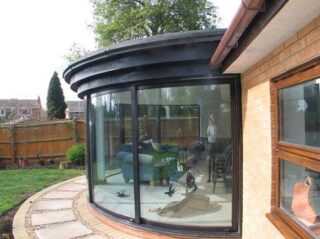
Glazing of the veranda with cellular polycarbonate can be done in several ways, the choice of which is determined by the characteristics of the room and the priorities of its owners.
By the degree of protection:
- vandal-proof with monolithic plates;
- decorative with honeycomb panels.
By the shape of the roof:
- pitched;
- arched;
- domed;
- pyramidal;
- wavy.
By glazing volume:
- complete;
- partial;
- panoramic.
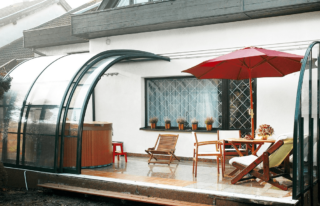
By functionality;
- cold;
- warm.
If you put polycarbonate on the veranda roof, you can achieve a significant heating effect on the terrace. The stoves store solar energy, creating a greenhouse effect. Therefore, if you make a transparent roof, you need to immediately think about ventilation issues.
How to choose polycarbonate for veranda glazing
The selection of the material with which it is planned to glaze the extension depends largely on its area, configuration, size of window openings, place and method of installing the sheets.
It is advisable to use monolithic slabs in hard-to-reach places and where strength and reliability are needed.It is advisable to close window openings that face the street and the roof with a slight angle of inclination. It should be remembered that a transparent polycarbonate terrace roof will be subject to heavy snow loads.
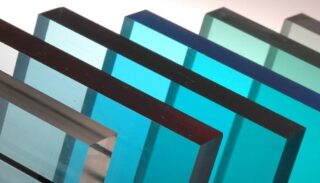
Honeycomb panels, due to their flexibility, are well suited for glazing in a protected area, as well as for creating curved structures of varying complexity. Hollow slabs can be used to cover light frames and large windows that do not have support on the foundation, including panoramic openings.
It is advisable to install transparent sheets on the shady side of buildings, where they will provide maximum illumination of the room. Colored and tinted panels are best placed on the roof and sunny side. The covering will diffuse and dim the bright light, creating a pleasant atmosphere in the room, and in low natural light, the windows can be opened.
When designing, you need to choose the right thickness of polycarbonate.
Monolithic slabs with a thickness of 8-10 mm are used for roofing, panoramic windows and transparent doors. Sheets of 4-6 mm are allowed on the vents and small openings in the frame.
Honeycomb panels 4-6 mm can be used for windows, transoms and interior partitions.
Products 8-10 mm are strong enough and rigid enough to be considered as a barrier to intruders or a surface that can withstand heavy snow and wind loads.
Required materials and tools
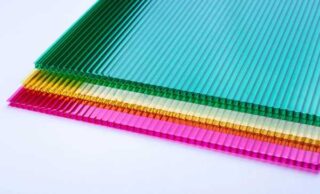
To glaze the veranda with monolithic polycarbonate with your own hands, you will need the following tools:
- roulette;
- level;
- screwdriver;
- hacksaw;
- Bulgarian;
- scissors;
- jigsaw;
- ladder.
List of materials:
- perforated tape;
- sealant;
- plastic or aluminum profiles;
- self-tapping screws with silicone washers;
- profile pipes or timber for the frame;
- polycarbonate.
To avoid injury, you need to prepare a visor, gloves and a construction helmet.
Preparing polycarbonate for terrace cladding
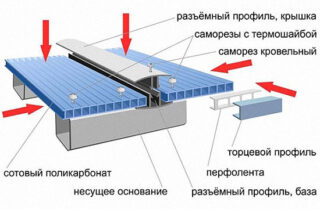
It is advisable to make the frame in proportion to the size of the boards in order to avoid a large amount of scrap. For honeycomb slabs, an interval of 70 cm is taken, and for monolithic slabs 100 cm. After taking measurements, the material is cut out. It is necessary to calculate everything so that there is a distance of 15-20 mm between the sheets on the supporting profile, which is required for correct laying and ensuring thermal expansion.
After cutting, you need to carry out the following actions:
- remove sawdust from the honeycomb with a compressor;
- align and deburr the edges;
- remove the shipping film;
- cover the ends with membrane tape.
The preparation of open slabs must be carried out on a flat surface with a soft surface to prevent cracks and scratches.
How to sheathe a veranda with polycarbonate with your own hands
When sheathing the veranda with polycarbonate, a number of rules for installing the material should be taken into account, depending on the specifics of the tasks to be solved.
In the manufacture of swing-type windows and vents, fragments of honeycomb plates are installed with a vertical arrangement of channels. The edges should not touch the frames; a drainage cavity and external holes for condensate drainage are made under them.
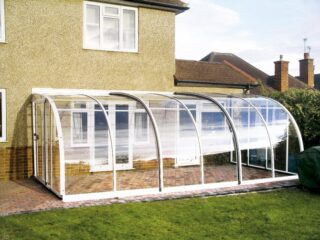
When building a veranda with opening windows, you need to take into account the quality of polycarbonate, such as flexibility. In strong winds, the insert can simply be squeezed out. For a 4 mm honeycomb panel, the frame area should not exceed 0.5 m². As the thickness increases by 1 mm, the allowable area increases by 30%. The permissible maximum for centimeter panels is 2.5 m² at moderate wind strength.
An excellent option for glazing a terrace is a sliding system. This design looks airy and allows you to save useful space inside the room. To move the canvases along the perimeter of the openings, guides are installed.The problem of sliding and sealing is easily solved by using high-quality seals.
Chrome handles will look good, and even better - made of glass or monolithic polycarbonate. Windows can open in one direction or move over the entire glazing area. Here the owners look at the features of the premises and its design.
Sheets thicker than 16 mm have thermal insulation properties similar to factory-made glass units. Therefore, such slabs can be used to form walls and roofs using T-shaped mounting profiles for connection.
Tips & Tricks
It is recommended to finish the extension with polycarbonate at a positive temperature and dry weather.
Do not glue the ends of the plates with tape, as it closes the paths for the drainage of condensate. Over time, the material becomes cloudy and becomes covered with dirt from the inside.
To fix the panels on the profile, you need to tighten the self-tapping screws so that the free movement of the coating is ensured when the temperature changes.
Curved roof contours look beautiful. If skills allow, you can give the frame the desired shape yourself using forging or a pipe bender. Alternatively, you can purchase a greenhouse kit with the corresponding dimensions of the parts.









What are you carrying? There is no polycarbonate glazing. Glazing is done ONLY with glass. Polycarbonate can be coated, but how not to glaze? ♂️